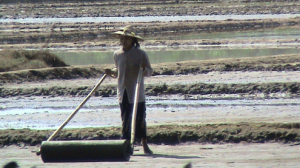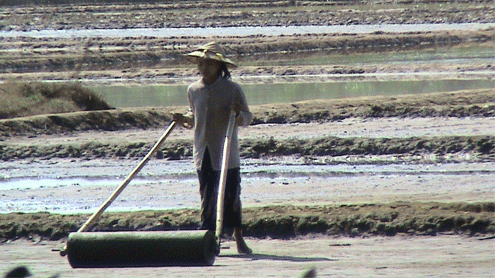By RAI MARAOH – Salt prices have jumped due to unusual heavy rainfall during the summer season and the increase in buying by China in the hopes of staving off radiation from Japan’s nuclear power plant.
The price of raw salt for one viss (Burmese measurement) hit 60 kyat within three days from March 19th to 21st. According to Nai Tin Aung, a salt field owner of 30 acres of salt in Panga village, Thanphyuzayart Township, before then, the price was 40 kyat per vices.

“I sold 150,000 viss within three days and received 100 kyat per viss. Many people came to buy it. They were from Moulmein, Rangoon, and Mandalay,” he said.
Nai Tin Aung mentioned two reasons for an increase in salt prices; Mon State was unable to produce a lot of salt this year due to heavy rainfall that destroyed the salt fields and that China has bought a large amount of salt since the tsunami hit Japan.
Htay Htay Mon, a salt producer in Moulmein, said that one bag of salt (30 viss) hit 6,500 kyat yesterday, though previously the price was only 2,800 kyat.
“There is not enough of salt this year. This is why many people are trying to buy it now,” she said.
Unusual rainfall hit Mon state on December 3, 2010, January 11, 2011, and March 14, 2011. According to Nai Tin Aung, most of the salt fields in Mon State were destroyed because of heavy rain.
“I collected 0.5 million viss of salt last year. But, I only collected 200,000 viss this year. The season of salt production has almost ended. I am sure I will not get back my 10 million kyat from my investment,” he said.
In Mon State, where there are over 10,000 acres of salt fields, salt businessmen are losing money on their investments in their salt fields, similar to Nai Tin Aung. He explained that rain poured on the salt fields while they were collecting the raw salt.
Before the increase in the last few days, this year salt prices had been comparatively cheap as salt areas in the Irrawaddy Delta began to recover from Cyclone Nargis in 2008. After Cyclone Nargis hit the Irrawaddy Delta in Burma in 2008, salt prices in Panga village and other parts of Mon State were 400 kyat per viss.
Mon State produces 10 percent of the salt in Burma.

